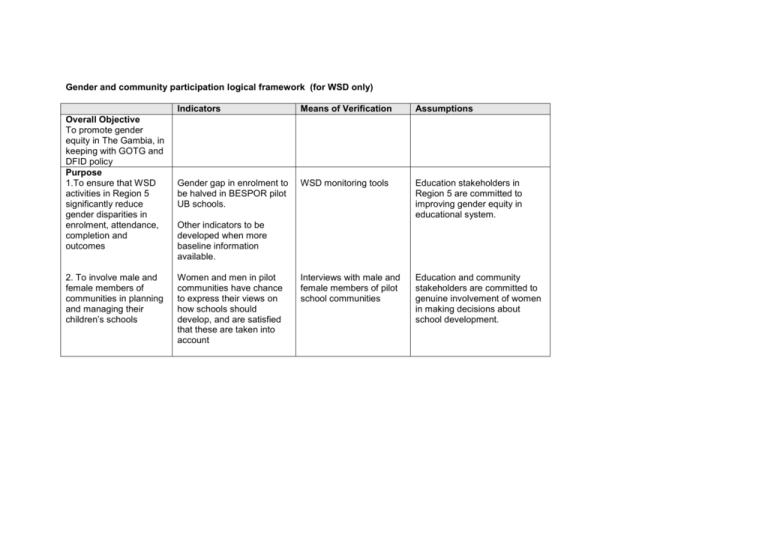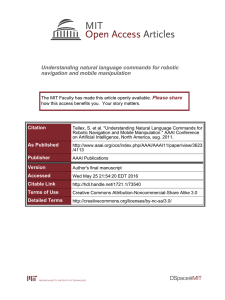Whole School Development Logical Framework
advertisement

Gender and community participation logical framework (for WSD only) Overall Objective To promote gender equity in The Gambia, in keeping with GOTG and DFID policy Purpose 1.To ensure that WSD activities in Region 5 significantly reduce gender disparities in enrolment, attendance, completion and outcomes 2. To involve male and female members of communities in planning and managing their children’s schools Indicators Means of Verification Assumptions Gender gap in enrolment to be halved in BESPOR pilot UB schools. WSD monitoring tools Education stakeholders in Region 5 are committed to improving gender equity in educational system. Interviews with male and female members of pilot school communities Education and community stakeholders are committed to genuine involvement of women in making decisions about school development. Other indicators to be developed when more baseline information available. Women and men in pilot communities have chance to express their views on how schools should develop, and are satisfied that these are taken into account Output 1 A model for girl-friendly UB schools is successfully piloted in Region 5 Output 2 All BESPOR pilot LB schools are ‘girl-friendly’ Output 3 Priority interventions for increasing proportion of female teachers in rural areas identified and piloted Gender gaps in enrolment, attendance, completion and performance are significantly reduced in pilot GF-UB schools in Region 5 in Yrs 2 & 3. Rates of teenage pregnancy reduced in pilot schools. Quarterly/Annual Progress Reports Pupil Assessment reports Teaching & Learning Conditions survey Longitudinal case-studies EFA Assessment Reports for Region 5 (BESPOR monitoring tools) Successful integration of GFUB model into school dev. Planning process Model approved for replication in other regions DOSE memos, minutes of meetings Girls feel comfortable in BESPOR pilot schools and any girl-adverse gender gaps in enrolment, attendance, completion and performance are significantly narrowed BESPOR monitoring tools (see above), and interviews with female pupils GOTG will continue to fund demand-side interventions e.g. advocacy & campaigning against girls’ early marriage Study carried out and recommendations made Report of study available Recommendations implemented for BESPOR pilot schools in Region 5 Observation, regional education authority meeting minutes & other documents, interviews with female teachers in Region 5 Priority interventions are identified that are a. likely to be effective in increasing numbers of female teachers in rural areas and b. feasible in cost terms Support from stakeholders Sufficient funding available to implement Output 4 Ways to address gender imbalance against boys in specific communities identified Output 5 Investigate gendered attitudes to, and experience of, corporal punishment in schools Study carried out and recommendations made & disseminated Study carried out and recommendations made Report of study available; seminar and other dissemination activities take place Report of study available; seminar and other dissemination activities take place DOSE is interested in targeting this problem Resources are made available outside BESPOR to implement interventions recommended by study DOSE is interested in targeting this problem Stakeholder sensitivities (e.g. teachers) can be managed Children are willing to talk about their experiences Output 6(community participation) School development planning mechanisms that are genderequitable and genuinely participatory Roughly equal numbers of men and women take an active part in SDC meetings OR SDCs have formal mechanisms in place to consult women, e.g. through Mothers’ Clubs. Poor people & people from marginalised groups take an active part. Observation of SDC meetings, minutes of SDC and Mothers’ Club meetings, interviews with female teachers, SDC and Mothers’ Club members, and community members in general Cultural constraints may make it hard for women to take part in SDC meetings on equal footing with men Local power-holders may dominate SDCs









